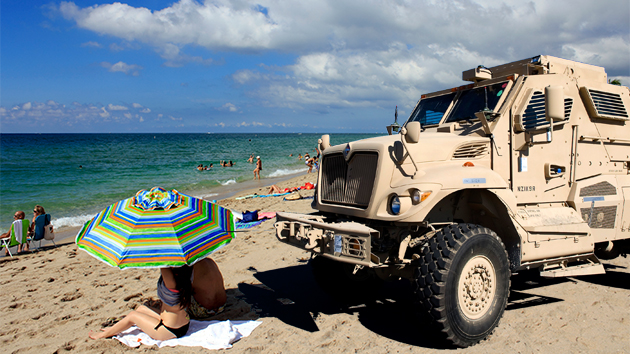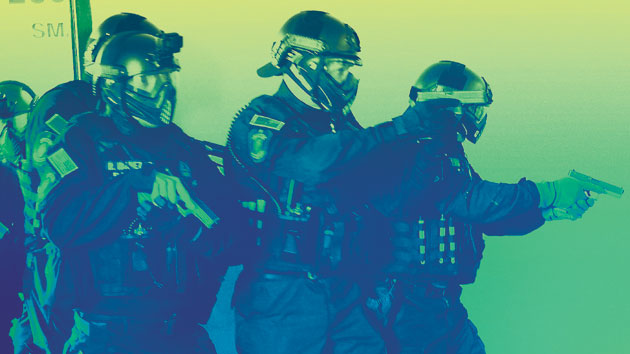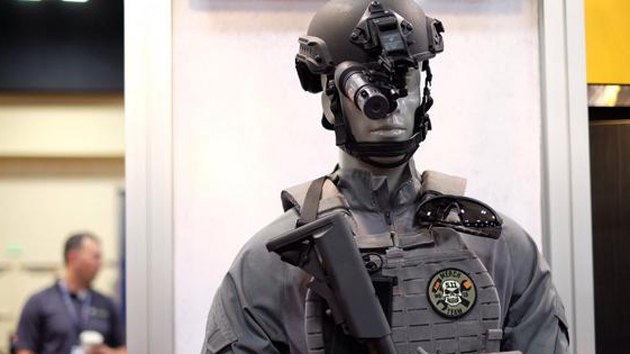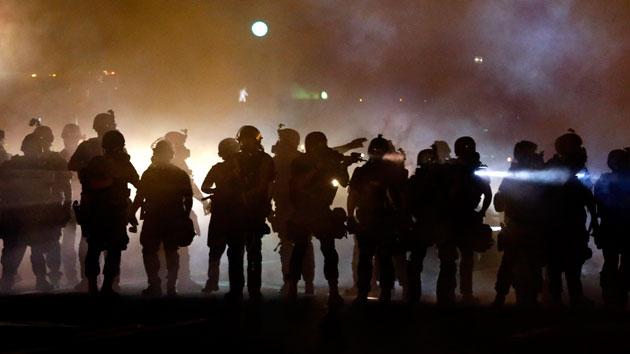
Images: AP/iStock.
Mother Jones obtained more than 450 police department requests for armored tactical vehicles from the Pentagon. Did your police force request one? Browse all of them here.
One year ago this week, hundreds of camouflaged officers in Ferguson, Missouri bore down on residents protesting the police shooting of an unarmed black teenager named Michael Brown.
Riot cops, their faces sometimes concealed by gas masks, fired off tear gas canisters, and as they stood on top of hulking, mine-resistant vehicles, they appeared to train their assault rifles on the crowds. On some nights, they greeted demonstrators with a storm of rubber bullets.
Images of this chaos provoked a furious debate over the billions of federal dollars that have helped local police forces amass combat style weapons, trucks, and armor. Sen. Claire McCaskill (D-Mo.), echoing concerns from across the political spectrum, fumed that “lawful, peaceful protesters did not deserve to be treated like enemy combatants.”
Law enforcement agencies responded by stoking old fears. No community, they argued, not even the smallest one, is safe from worst-case scenarios like mass shootings, hostage situations, or terrorist attacks. The use of this military equipment has resulted in “substantial positive impact on public safety and officer safety,” Jim Bueermann, the president of the Police Foundation, a research group, said in a 2014 Senate hearing on police militarization. He cited hostage situations, rescue missions, and heavy-duty shootouts where the vehicles had come in useful.
But in private, police justify these same programs in radically different ways.
Mother Jones obtained more than 450 local requests, filed over two years, for what may be the most iconic piece of equipment in the debate over militarizing local police: the mine resistant ambush protected vehicle, or MRAP.* And an analysis of these documents reveals that in justifying their requests, very few sheriffs and police chiefs cite active shooters, hostage situations, or terrorism, as police advocates do in public.
Instead, the single most common reason agencies requested a mine-resistant vehicle was to combat drugs. Fully a quarter of the 465 requests projected using the vehicles for drug enforcement. Almost half of all departments indicated that they sit within a region designated by the federal government as a High Intensity Drug Trafficking Area. (Nationwide, only 17 percent of counties are HIDTAs.) One out of six departments were prepared to use the vehicles to serve search or arrest warrants on individuals who had yet to be convicted of a crime. And more than half of the departments indicated they were willing to deploy armored vehicles in a broad range of Special Weapons and Tactics (SWAT) raids.
By contrast, out of the total 465 requests, only 8 percent mention the possibility of a barricaded gunman. For hostage situations, the number is 7 percent, for active shooters, 6 percent. Only a handful mentioned downed officers or the possibility of terrorism.
“This is a great example of how police as an institution talk to each other privately, versus how they talk to the public and journalists who might raise questions about what they’re doing with this equipment,” says Peter Kraska, a professor at Eastern Kentucky University who has studied police militarization for decades. When police are pressured in public, Kraska says, “They’re going to say, ‘How about Columbine?’ or point to all these extremely rare circumstances.”
The requests flowed to a massive Pentagon program—known as the 1033 program—that has given communities across the country a total of $5.6 billion in combat equipment left over from the wars in Iraq and Afghanistan, including, a spokeswoman for the Pentagon said, 625 MRAPs. A 2014 NPR analysis found that the Pentagon has also doled out 80,000 assault rifles, 200 grenade launchers, and 12,000 bayonets. In 2012, the program began making MRAPs available. The vehicles weigh around 14 tons, and feature armored hulls and tiny, blast-proof windows. “Nothing short of a rocket-propelled grenade will trouble this powerhouse,” one manufacturer boasted.
The documents reveal that many departments are willing to bring a startling show of force to ordinary communities. One police chief pleaded for a Lenco BearCat—an armored personnel carrier with blast resistant floors and an optional gun turret—to guard a 200-acre beach town in Delaware. In Chesterfield County, South Carolina—population 46,000—the sheriff requested a vehicle that could withstand both roadside bombs and a type of machine gun round that can shatter concrete. And the Ohio State University Police Department asked for an armored vehicle to assist with “football missions.” (The Pentagon gave Ohio State an MRAP in September 2013, and school police deployed it to football games, the department told a student newspaper, so as to have a “presence.”) Many departments explicitly promised to use MRAPs to deliver drug-related search and arrest warrants.
The focus on drugs may owe partly to the fact that the Pentagon originally launched the 1033 program to help local agencies fight the domestic war on drugs. But starting with the terrorist attacks of September 11, 2001, the federal government vastly expanded the program, and created new, larger funding streams that help agencies purchase new combat equipment, under the guise of readying local police forces for future attacks.
Law enforcement advocates today dispute that police are using their heavy combat equipment primarily for drug enforcement. Jim Pasco, the director of the Fraternal Order of Police, suggests that police departments were probably just writing down what they thought the Pentagon wanted to hear. “In reality, they’re almost exclusively used as defensive tools,” Pasco says. It’s a rare drug enforcement case that would require an MRAP, he adds. “We’re talking barricaded shooters and downed officers.”
But civil rights advocates have observed that SWAT teams—the specialized officers who use these vehicles—are now overwhelmingly deployed for drug raids and search warrants. In a 2014 report examining 800 raids, the American Civil Liberties Union found that SWAT teams replaced regular uniformed police officers in executing search warrants, mostly on private homes, in 80 percent of cases. The raids disproportionately targeted minority residences, and evidence that the raid would be dangerous for the officers was often scarce. Sixty percent of the raids involved a drug search—meaning the subject of the search warrant had not yet been convicted of a crime—and 36 percent of the raids turned up no contraband at all. Raids for minor drugs charges, the report continued, have frequently resulted in officers killing and maiming unsuspecting residents and even children—including a 19-month-old boy who was injured when an officer chucked a flash-bang grenade into his crib.
“Most will agree that the line between military and local law enforcement needs to be clear,” says Kanya Bennett, an attorney with the ACLU. “And when you’re incorporating military weapons and equipment into day-to-day policing, that line becomes blurred, and it undermines the trust that previously existed between communities and police.”
The documents show just how much that trust has eroded as officers come to see citizens as enemy combatants. A 2013 request from the Okeechobee, Florida sheriff’s department asked for an armored tactical vehicle capable of carrying “multiple troops”—not “officers”—to serve drug-related search warrants. For the sheriff of Bastrop County, Texas, a tactical vehicle would calm his fears of the proliferation of firearms—including, it seems, guns that local citizens own legally. “Subjects may sometimes be armed with high powered rifles and handguns,” he wrote, “as most of our citizens own rifles due to a long tradition of hunting and sport.” Two police departments—in Snoqualmie, Washington and Garden Grove, California—hinted they would use the vehicles for crowd control.
And in a sign of just how commonplace the use of military grade vehicles has become, multiple departments pointed out that they did not have an armored vehicle as a reason they ought to get one. One department stressed that the closest armored truck was 30 minutes away. “That’s an astonishing claim,” Eastern Kentucky’s Kraska says. “Do we have to have a full SWAT team with an armored personnel carrier ready to be deployed in a response time of 10 minutes in every community in the country? Because obviously, that would be very disturbing.”
Only a few dozen of the departments represented here have received an MRAP in response to their requests, according to Pentagon data obtained by the New York Times and the Marshall Project. But the documents Mother Jones obtained show that nearly all of these departments were placed on the Pentagon’s national priority list of agencies in line to receive MRAPs as they return from overseas.
Some of the agencies waiting in line, however, have a history of questionable SWAT operations.
Take the Kenosha County sheriff’s office, which requested an armored tactical vehicle to use as part of a multijurisdictional SWAT team. Two years after making its request, several Kenosha County sheriffs joined the Department of Natural Resources in a SWAT-like raid on a no-kill animal shelter that was raising a baby deer—Giggles—in violation of the state’s wild animal laws. (The DNR seized and euthanized Giggles.)
Some requests were simply odd.
In 2013, police chief Samuel Mackert of Dewey Beach, Delaware asked for a Lenco BearCat. (According to a press release on Lenco’s website, “It’s almost like driving a tank.”) “Dewey Beach has been consistently in the top 10 beaches in the US,” Mackert wrote. “It covers one square mile, which during summer months explodes in excess of 30,000 in population. The potential to need an armored tactical vehicle,” Mackert continued, “is probable.”
A spokesman for the Dewey Beach police says that since filing the request, the department “has not experienced any situations in which we felt an armored tactical vehicle could have been utilized.” But, he added, “This agency does feel though that an armored vehicle would be a useful asset should the department encounter an active shooter, armed barricaded subjects, or to rescue victims or officers in these types of incidents.”
In 2013, Police Chief David Uhl from Dundee, Michigan asked for a tactical vehicle in part to secure the local Cabela’s, a big box hunting and fishing retailer. Uhl said that the store was the “#1 tourist attraction in the state” and seemed to claim that the Dundee store was Cabela’s largest location. The Detroit Free Press reported in 2014 that the Pentagon sent Dundee an MRAP. Dundee police did not respond to a request for comment. A spokesman for Cabela’s says its largest store is in Hamburg, Pennsylvania.
Law enforcement agencies claimed they needed MRAPs to safeguard trailer parks, shopping malls, theme parks, Halloween festivals, and Lambeau Field.
But for every bizarre request, there were legitimate-seeming claims of true danger. A few agencies noted that they had recovered high-powered weapons in raids or claimed run-ins with heavily armed cartel members. Some sheriffs were distressed about white supremacy groups and sovereign citizens. A police chief in Centralia, Washington, without giving specifics, said an armored vehicle had once saved his life. Many agencies argued that they couldn’t pay for an armored vehicle any other way.
The Garden Grove police department in southern California noted that the city was home to “the largest Mosque west of the Mississippi.” The mosque is always at risk of becoming a target, says Bob Bogue, a lieutenant in the department. In fact, it’s happened before: On the day of the attacks on the World Trade Center, Bogue says, police apprehended a suspect approaching the mosque with a gun.
But officers arrested the would-be attacker without a single shot fired, making it unclear how an armored vehicle would have helped. And Garden Grove’s request for an MRAP suggested a use that seems controversial in light of the Ferguson protests: to respond to civil demonstrations in neighboring Anaheim. Anaheim experienced widespread protests in 2012 after police officers killed two Latino men in quick succession.
In the future, Bogue said, Garden Grove would be ready to respond such disturbances with an MRAP. The town received a vehicle last year but has yet to put it into use. “What city could you live in that you wouldn’t hope your police department can come help save you?” Bogue asks.
“You just never know from day to day what our job is going to consist of,” says Kent Holcomb, the police chief in Nocona, Texas. Holcomb requested an MRAP to respond to occasional bomb threats in his district. Nocona is still on the waiting list. “The world is changing. With the way people are acting, you can’t predict anything.”
Opponents of police militarization counter that the way law enforcement uses SWAT gear is very predictable. “High stakes scenarios—they’re not where these vehicles are routinely deployed,” Bennett says. She also noted that police consistently overestimate the dangers of routine police tasks: The 2014 ACLU report found that so-called “high-risk” warrants were often classified that way because an officer believed, without any evidence, that the subject had a gun.
Others point out that local police work has actually grown safer year after year—the result of a precipitous drop in the overall rate of violent crime that has rendered a lot of SWAT equipment unnecessary.
And some police officers agree.
Sheriff Jay Brooks of Chesterfield County, South Carolina is one of them. Brooks’ predecessor, Sam Parker, acquired a 12-ton tank from the Pentagon several years ago. Looking to further augment his fleet, Parker put in for another tactical vehicle—one with wheels instead of a track—in 2012. His ideal vehicle, he wrote, was “capable of stopping up to a .50 [caliber] round and with blast protection in the underbelly for protection from booby traps or improvised explosive devices.”
Parker went to prison last year; he was convicted on eight counts of public corruption, including embezzlement. And Brooks is busy trying to get rid of the military gear he amassed.
“I do not care for the military look,” Brooks says. “We go to great lengths to make sure we don’t look like a militia instead of a sheriff’s department.” Recently, he parked the tank behind police headquarters where it would be out of sight.
Other departments have reconsidered, too. The campus police department at tiny Cerritos College in California—which wrote in its request that it needed protection from shrapnel—decided that it could rely on Los Angeles police in the event of an emergency, and it withdrew the request, a spokeswoman said.
Brooks says that in the 28 years he has been an officer in Chesterfield, he has never heard of anyone firing a .50 caliber weapon or setting off a roadside bomb.
“I’m not saying it could not happen,” Brooks continues. “But we’re just a regular county. And if we need anything heavy, if we need anything armored, our state law enforcement is one phone call away.”
* The documents Mother Jones obtained, under the Freedom of Information Act, included some requests in which agencies did not specify what type of armored tactical vehicle they preferred.
Search more than 450 local law enforcement requests for mine resistant ambush protected vehicles:
















